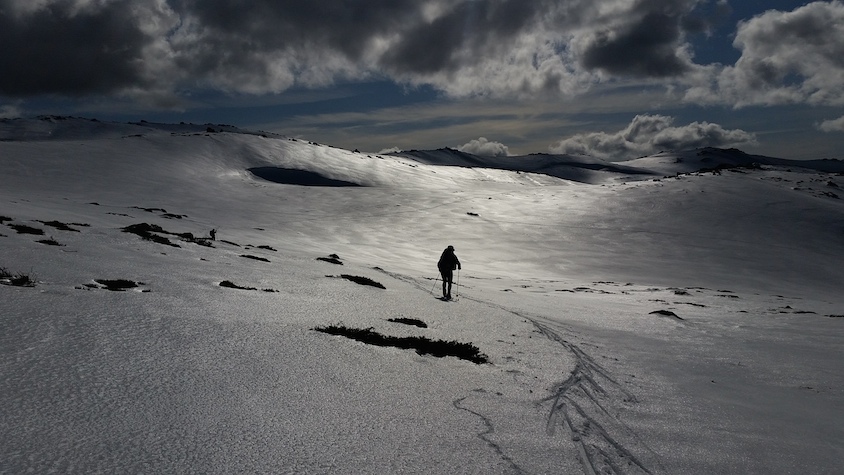Paddy Pallin has long been associated with outdoor activities. The original Paddy Pallin Ski Classic was held between Round Mountain and Perisher in 1965, as a means to popularize cross-country skiing. The 1965 event was recognised at the time as an epic, it came a year after Paddy instigated his first Paddy Pallin Orienteering event. These events were successful in promoting the two sports.
The 50th Paddy Pallin Rogaine was successfully held in 2013 with 1000 competitors.
The Paddy Pallin Junior’s ski event was held this year for the 57th time, making it the longest continuously running cross-country ski event in Australia.
The original (1965) Paddy Pallin was held a day after the National Champs which were held that year in Cabramurra. The start was at Round Mountain, finishing at Perisher and the course was approximately 60 kilometers in total. There were only six competitors, all fit. They had were limited ski tracks, no accurate topographic maps, and there was little race support. The weather conditions deteriorated, so for safety reasons the competitors called a truce and they stayed together. Despite no ski tracks, the competitors completed the course in only 7.5 hours and the legend of a truly epic trip began.
The Paddy Pallin Classic went on to become Australia’s toughest race, it is still conducted annually now called the Snowy Mountains Classic.
Planning for the 50th anniversary commemorative event
This 50th event was envisaged to commemorate that age of daring, with the hope that there would still be skiers interested in backcountry skiing.
The NPWS were quick to provide in-principle approval, subject to conditions which in this day and age can only be described as reasonable. They included the necessity to have insurance, Personal Locator Beacons, and safety gear sufficient for an overnight stop independent of the huts. The need for insurance was a difficulty that committee members of Rogaining NSW were quick to offer assistance with.
All that was needed were competitors, so an expression of interest was circulated widely before the ski season. Unfortunately less than a dozen people expressed any interest, and due to a weather delay of one week and some injuries, there were only three starters at 6am on 5th September, these being Mike Edmonson, Michael Stenning and David Hislop.
Equipment
The choice of lightweight versus safety was difficult for this to be a safe day trip. Wanting to have a fast trip, we went for racing skis. For some surety against slow snow, classic skis were chosen. Edmonson and Stenning used zero skis, while Hislop chose skaters, and took a few waxes.
We decided not to take sleeping bags, nor a tent, but each had a bivvie bag, foam mat, and medium to heavy gortex wet weather gear. We each had at least four layers of warm clothing, but it would have been a cold night. We had a rudimentary repair kit, including duct tape. Some food for overnight, and firestarters.
The Trip
The late drive to Kahncoban made for some bleary eyes the early start. There were trees on the road, but we managed to drive to the trail head at Round Mountain before dawn. After a final check of gear, and parting words from Pat Edmonson we departed at 6am.
At only 1600 metres altitude the snow was patchy, so we left in running shoes. After only one kilometre we found snow, but decided to take our runners with us. The first five kilometres offered patchy snow but we managed good time, making Derschko’s Hut in under two hours. Here a quick entry in the log book revealed we were only the fourth party for the winter, which surprised us. Certainly 50 years ago the area would have been more widely travelled.
From Derschko’s we climbed the southern flank of Jagungal to quickly gain 1800 metres altitude. Here we had good snow, which was softening quickly and it made for some great skiing. There seemed little need to pull out the map, and to use Paddy’s words we were “never truly lost”.
We made the Big Bend – at about the half way point – by 10am, but from here the snow was heavy and classic skiing or stepping was required for the uphills. We stopped for water in a creek above Schlink Pass at 1pm. It took three hours to cross the Rolling Grounds in heavy snow, which made it difficult going both up and down hill. It was a delight to finally have soft snow for some great turns into Guthega Dam.
From here we had time to visit some friends at Brindabella Lodge. The hospitality included wood fired pizza which delayed the final leg somewhat. The sun was setting as we topped Blue Cow, after making it difficult to find the road to North Perisher. Here we stumbled on a couple of snowboarders who were preparing for the long walk back up to Mount Blue Cow. A quick phone call to Alan (Barney) Davis helped us find our way.
We finished in the dark, after 12 hours of memorable skiing. The views, the terrain and the generally kind weather truly make this some of the best ski touring in the world. It has surprised us so few people are enjoying it.


